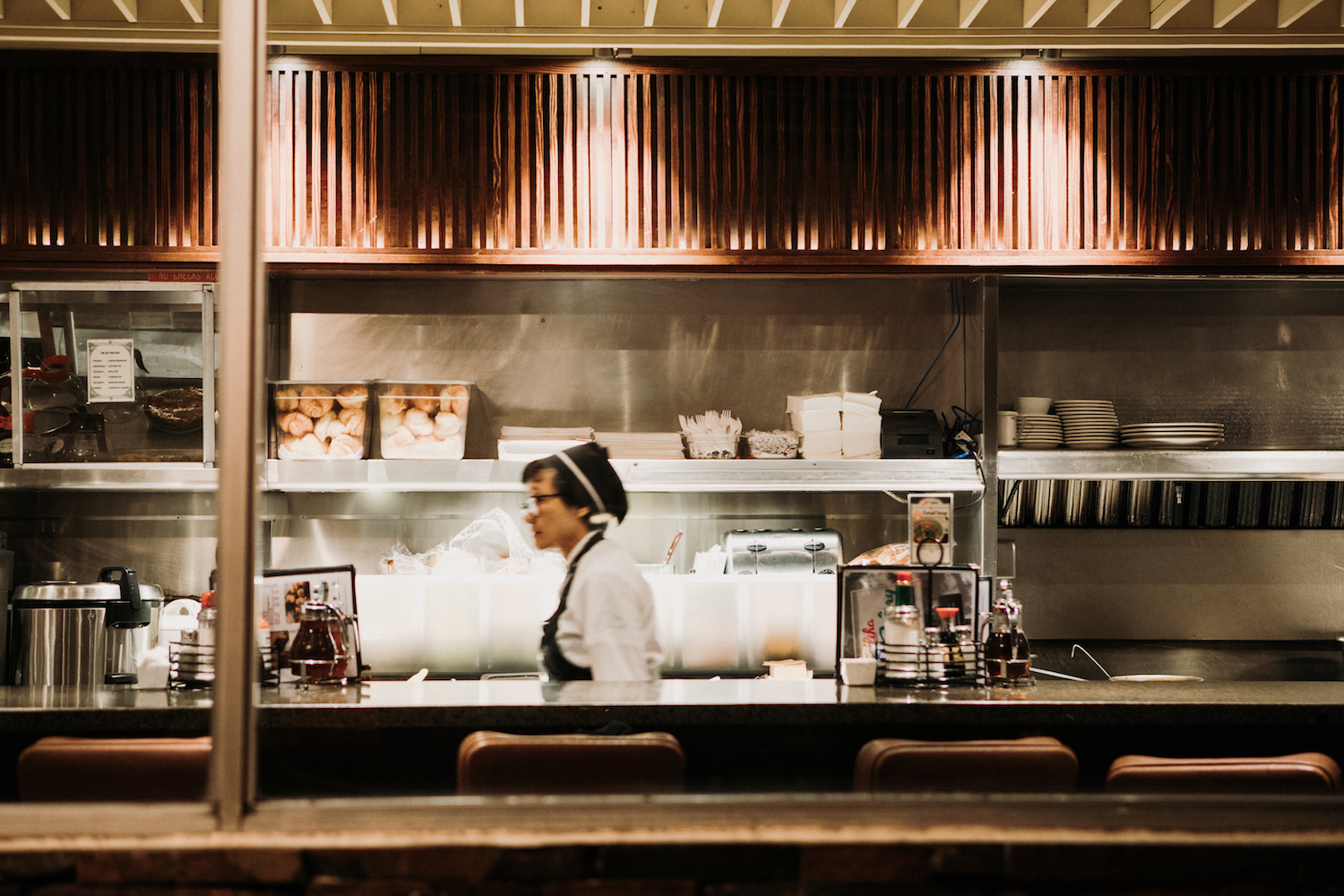The late-night diner doubles as a place for patrons to eat and somewhere to conveniently remove yourself from the world and enter a sanctuary of strangers.
The most opportune hour to visit your local diner must be sometime between 3 and 5 a.m. A certain solitude can be found there in the minutes you can’t confidently call night but wouldn’t pin down as day. Often, that solitude is literal, straightforward, and bare—meaning there is not another soul to tally, aside from your blank-faced self, dining there. You place your ready-set order after reading blindly from a menu glossy with daily specials that rarely, if ever, change.
Other times, you may be in the presence of other eye-rubbing denizens, their elbows resting atop laminate tabletops, the mirror image of you, weighing whether they are in the mood for fried rice or a waffle recipe that hasn’t been modified in ages. You’re not alone, yet a chasm of a solace still exists, only now it’s shared between the unplanned party of two, or five, or nine of you, all sitting there blank as balloons. Who are these statuary people spread thin across the diner during these hours? What could they possibly be doing here? When we tuck ourselves away into a booth, I suspect we all spend a sliver of our time asking ourselves these sorts of questions.
Tonight, there happens to be an elderly gentleman, the type to read a magazine delicately, page by page: Why isn’t he doing that on his living-room chaise? The waitress filling your water glass who ends all her phrases with “sweetheart:”
Does she have one? Two haole men in cowboy hats chatting with a sistah in a tita bun: What’s … happening there? Open the aperture on this scene slightly to allow in light from the hours leading up to and following this two-hour window, and more individuals enter the frame. We have construction workers before construction-working, little-league baseball players after baseball-playing, gossiping aunties gossiping about someone else’s aunty—is it your aunty? Someone is shouting, someone is mumbling.
What’d they say? Young folks, old folks, fine folks. Faces reflected in glass windows and pastry cases, expressions lit up briefly by the lights of passing vehicles and blinking cellphone screens. Faces belonging to someone you might recognize and someone you’re destined to forget: Who knows?
I adore these public questions posed by entering my local diner. More than the lukewarm Lion coffee and Liliha Bakery’s radioactive-bright jelly, if only to remind us that the ordinary people in our midst are so much more mysterious than anything we could ever brew and bake up. It’s this catholic cast of characters, so specific, but innominate, that captures my imagination—they are so plain and convincing! Diners at late-early hours hold the same air of wonder and melancholy that understandably makes Edward Hopper’s painting Nighthawks his most renowned. Though Hopper has claimed this painting was not consciously meant to be a reflection on human isolation and urban loneliness, his view of a Greenwich Avenue diner in downtown New York can easily be a stand-in for whatever might unfold at Zippy’s along Nimitz Highway or Ken’s House of Pancakes on the outskirts of Hilo Bay.
Diners at nighttime prove to be a natural canvas. There’s a tenet across creative endeavors, from oil paintings to retail window displays, that by isolating something, you illuminate it. This notion is melded with voyeurism, another essentialism for most figurative artmaking which happens constantly among us in the heightened confines of the diner.
Then there’s the benefit of how time tends to operate in them—how it allows you to observe the eloquence in human fatigue, to pick up on the poetry of someone’s profile or their posture, the caress of a leg wrapped around a vinyl stool, a rubber slipper dangling off a foot. It’s a world that moves at an entirely alternative pace. Where the flush of orders coming and going mingles with the sound of clinking dishes and just-out-of-reach chatter. Twenty-four-hour diners: the crinkly radio static between FM radio stations, the white noise of meats sizzling on the grill. A red-eye flight with its minimal demands, only asking you to sit there breathing until you land back on solid ground.
Unlike the tangle of human storylines that crisscross in places like shopping malls or the DMV, the diner is more akin to a public park. Or an underfunded aquarium. What restaurants are to flashy theme parks diners are to fish tanks. Actually, diners are most aligned with churches. Tables traded for pews, menus treated like a biblical text, their contents trusted and memorized by devoted regulars.
Our diner, who art in Liliha, or Kalihi, on Ke‘eaumoku, or Pi‘ikoi. Ever consider how their aproned waitresses are dressed like nuns? The way they stride through aisles, always in sandals that never seem to squeak, floating about like angels? If you arrive alone, as one sometimes does, during those ungodly hours between night and day, to join the nave of the diner and break bread by yourself, not knowing what to do with your hands, you mindlessly hold them together as if in prayer.
The late-night diner: It can occasionally feel spooky, but in the most subterranean and indelible and confidential way. Here, among the company of strangers, you sense you are also your own individual person, glowing with your own insecurities and imaginations, going about a secret and uncertain path in the lighted dark.








